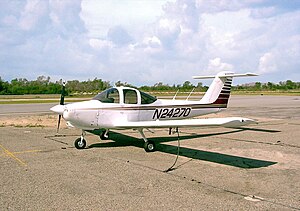Piper PA-38 Tomahawk
| PA-38 Tomahawk | |
|---|---|
 |
|
| Role | Light aircraft |
| Manufacturer | Piper |
| Introduction | 1978 |
| Produced | 1978–1982 |
| Number built | 2,484 |
The Piper PA-38-112 Tomahawk is a two-seat, fixed tricycle gear general aviation airplane, originally designed for flight training, touring and personal use.
The Tomahawk is a single-engined low-wing cantilever monoplane with a T-tail and an enclosed cabin for two. It has a fixed tricycle landing gear and is powered by a Lycoming O-235 four-cylinder piston engine with a twin-bladed tractor propeller. The Tomahawk has two front-hinged doors for access to the cabin.
The Tomahawk was Piper's attempt at creating an affordable two-place trainer. Before designing the aircraft, Piper widely surveyed flight instructors for their input into the design. Instructors requested a more spinnable aircraft for training purposes, since other two-place trainers such as the Cessna 150 and 152 were designed to spontaneously fly out of a spin. The Tomahawk's NASA GA(W)-1 Whitcomb airfoil addresses this requirement by making specific pilot input necessary in recovering from spins, thus allowing pilots to develop proficiency in dealing with spin recovery.
The Tomahawk was introduced in 1977 as a 1978 model. The aircraft was in continuous production until 1982 when production was completed, with 2,484 aircraft built.
The 1981 and 1982 models were designated as the Tomahawk II. They incorporated improved cabin heating and windshield defroster performance, an improved elevator trim system, improved engine thrust vector, 100% airframe zinc-chromate anti-corrosion treatment, better cockpit soundproofing, larger 6" wheels and tires for greater propeller ground clearance and improved performance on grass and dirt runways, among other enhancements.
According to the Aircraft Owners and Pilots Association Air Safety Foundation, which published a Safety Highlight report on the Piper Tomahawk, the Piper Tomahawk has a one-third lower accident rate per flying hour than the comparable Cessna 150/152 series of two-place benchmark trainers. The Tomahawk has a higher rate of fatal spin accidents per flying hour. The National Transportation Safety Board (NTSB) estimated that the Tomahawk's stall/spin accident rate was three to five times that of the Cessna 150/152.
...
Wikipedia
